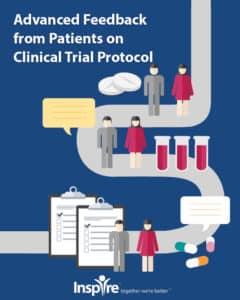Merck’s Patient-Centric Clinical Trial Recruiting

Merck boosts clinical trial recruitment with a patient-centric mindset
Everyone in pharma knows that product success depends on the results of clinical trials — but we don’t usually hear from the people who are involved in running them. Recently, four Clinical Research Managers (CRM) from Merck (known as MSD outside the United States and Canada) discussed how Merck is overcoming the barriers to clinical trial recruitment by adopting a patient-centric process — a model that affects their trials top to bottom, from design through implementation. Each of the panel members manages clinical trials, serving as the main point of interaction with the Clinical Research Associates (CRAs) on research requirements, goals, and resources, including recruiting and retention.
While few companies have the resources Merck can bring to the problem of recruiting for clinical trials (Merck invested $9.8 billion in R&D in 20181), most recruiting efforts could benefit from one powerful idea: Focus on getting people onboard. This includes people inside your own company. Why? Sometimes the bottlenecks in recruiting are interpersonal.
Adrelia Cabiness Allen, a CRM on special assignment to connect Merck with the communities of underrepresented patients in clinical trials, said that becoming patient-centric means ensuring that clinical trial diversity is a high priority for the company, “…not just pushing out clinical trials and saying, ‘This is what we need.’”
Allen continued, “We all have our area of expertise, but we are doing a better job of working collaboratively… and starting that work early. If we start [patient-centricity and diversity] conversations earlier, it has a trickle-down effect on how sites are selected, the access to patients, engagement with trusted voices in the community and patient advocacy groups. We can then begin forming partnerships to support our efforts to increase clinical trial participation in underrepresented patient communities.
For example, for an upcoming HIV program that is focusing on increasing female enrollment, Lisa Karsner, a CRM in Infectious Diseases, said, “…We went back to our participating sites, and asked if they had this population. ‘Do you have a relationship with them? How do you connect with them in the community? Is there a patient peer support specialist for women in particular?’ and so forth.” Being proactive to meet a particularly challenging recruitment goal involves groups both internal and external to Merck: Medical Affairs, Global Trial Optimization, trial teams, CRMs, CRAs, and the sites. “We had to get everyone on board.”
Changing the culture to increase the focus on patient-centricity isn’t easy, Karsner said. “We have to alter the mindset of not just our sites, but of our employees. I’ve been in research for over 30 years. …as human beings, we tend to go with what is familiar to us, because it’s easier. Trying to change the mindset of our CRMs, and our CRAs, to get them to understand the benefits [of patient-centricity] — we’ve really got to have these conversations early on.”
At all levels, lowering the barriers to clinical trial enrollment requires changing relationships and communication around the established scientific processes. Another CRM, Andrew Onikepe, was involved in recruiting patients with cardiovascular disease for trial sites in the US. Despite admittedly challenging eligibility criteria, some sites were succeeding. “We had to find out the root cause,” he said. Working with the CRAs, they surveyed 150 sites, with the goal of creating a “menu” of solutions from which the sites could select. “We knew it wouldn’t be a ‘one size fits all’ solution because some of these institutions are hospitals, some are local community, and they all receive patients differently.” He continued, ”As a company, we are starting to understand that we need to get the site’s feedback on what it is that they need [to achieve research goals].”
The result? The big difference at the sites that were recruiting successfully was that the patient heard about the clinical trial directly from the cardiologist. “The physician really needed to be involved in communicating what the study was about… with a heart failure patient, they trust what their physician is saying.” Merck then involved its Research Medical Science Directors, who gave training for site physicians on the scientific benefit of the trial, knowing that if the physicians were confident in the science, they were more likely to present the trial as an option to the patients. Onikepe was careful to point out that different trials would have different key relationships, but that they had to have feedback from sites and participants to reveal what those are.
For example, some prospective study participants are more likely to be receptive to information about clinical trials from trusted community leaders and advocates. For example Merck is working with PHEN, the Prostate Health Education Network, an advocacy organization working nationally with African-American communities to educate the public and promote participation in prostate cancer trials, because African-American men are at double the risk of dying from prostate cancer than any other population.2 PHEN’s creative approach includes rallies and even a stage play, Daddy’s Boys, to open conversations about disease and healing in this affected community.
Another suggestion for increasing enrollment is also based on the interpersonal. Rosanne Petros, a CRM working with vaccine trials, said people who are motivated by a loved-one’s condition can be part of future cures. “Everyone has a patient in their lives. They might not be in a position to help that person directly… But they also might not know that we need all kinds of people for clinical trials, not just people who are sick. We need [healthy people] too.” Even with the complex eligibility requirements for drug trials, all trials start with a set of normal healthy participants. “A healthy person can contribute to patients in the future by volunteering for a trial.” Petros herself is involved in a trial for a candidate medicine for treating high intraocular pressure. Prospective vaccines, antifungals, and pain medications, for example, are all evaluated in normal healthy people in addition to patients.
In closing, Allen said, “With the new clinical science we have available, clinical trial diversity is assuming a new priority in our era.” She said changing company processes to embrace patient-centric clinical trial diversity upholds the mission of Merck’s founder, George W. Merck, and quoted him: “He said, ‘We cannot rest till the way has been found, with our help, to bring our finest achievement to everyone.’”
Inspire works with clients to research the “real world” perspective of patients and caregivers and learn what influences them — including what influences a person to consider joining (and staying in) a trial.
Inspire offers a trusted community to patients and caregivers. Our goal with this blog, this website and our content is to provide the life science industry access to the true, authentic patient voice. In so doing, we support faithful operationalization of patient-centricity. Take a look at our case studies, eBooks and news outlet coverage.
Inspire thanks Merck and its Clinical Research Managers Adrelia Cabiness Allen, Lisa Karsner, Andrew Onikepe, and Rosanne Petros, for speaking with us on clinical trial diversity, with special thanks to Ms. Petros for arranging the panel meeting.
References
1https://www.merck.com/about/our-history/facts/home.html
2https://www.cancer.gov/news-events/cancer-currents-blog/2019/prostate-cancer-death-disparities-black-men






